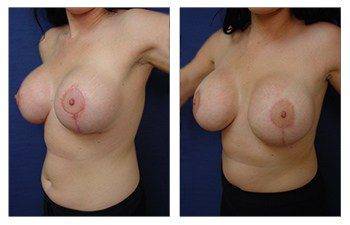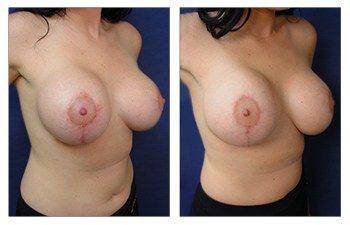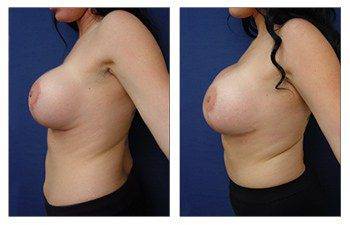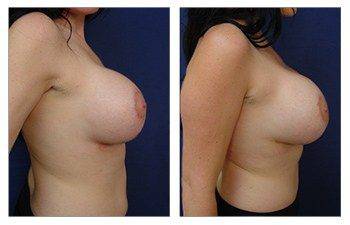





One of the biggest causes of breast augmentation revision surgery is breast size asymmetry and scarring. While this may be an unfortunate circumstance, a breast augmentation revision to correct breast size asymmetry and scarring will definitively fix your issue and get you those dream breasts you’ve always wanted!
There are several reasons for breast asymmetry such as incorrect sizing at your initial consultation or an incorrect post-operative protocol. Regardless, a consultation with a breast augmentation revision specialist is the logical next step to correct breast size asymmetry.
The key to correcting breast size asymmetry is proper implant sizing during your initial consultation. This patient showed breast asymmetry with a larger right breast. At her consultation with SurgiSculpt, she was sized to reduce her right breast implant and increase her left implant to achieve breast symmetry. We keep a full stock of both saline and silicone implant sizes so she was able to physically see the exact sizes that she required to achieve a balanced contour.
Additionally, a breast augmentation revision surgery gave our SurgiSculpt surgeons the opportunity to correct her periareolar scarring from her original breast augmentation. Notice the increased redness in the before photos compared to the after photos. We achieve this by employing a modified vertical mastopexy design that reduces tension on the periareolar region, enabling more successful healing. It is also combined with an inverted T-Weiss design to enhance the final breast shape.
Introduction: Breast Augmentation Revision to Correct Breast Size Asymmetry and Scarring
Breast augmentation is a widely sought-after cosmetic surgery procedure that aims to enhance the size and shape of a woman’s breasts. While it often provides satisfying results, some patients may require breast augmentation revision surgeries to address issues such as breast size asymmetry and scarring. This essay delves into the complexities of breast augmentation revisions and the various surgical and non-surgical methods used to correct these issues, with a focus on the importance of patient satisfaction and well-being.
Understanding Breast Augmentation and Its Common Complications
Breast augmentation is a cosmetic surgery designed to increase the volume and shape of the breasts. It is typically carried out through various surgical techniques, including different implant types, incision locations, and implant placements. The procedure is generally aimed at achieving specific aesthetic goals while improving body confidence and self-esteem. Nevertheless, despite its popularity and success rate, breast augmentation may lead to complications, two of the most common being breast size asymmetry and scarring.
Breast Size Asymmetry: Causes and Implications
Breast asymmetry refers to the unequal size, shape, or positioning of the breasts. While some degree of natural breast asymmetry is common, breast augmentation can sometimes exacerbate this condition or introduce new imbalances. The causes of breast size asymmetry in the context of augmentation include natural anatomical variations, surgical errors, postoperative changes, and implant-related factors. Such asymmetry can have profound emotional and psychological implications for patients, leading to body image dissatisfaction, reduced self-esteem, and increased psychological distress.
Breast Augmentation Revision for Asymmetry Correction
Breast augmentation revision procedures aim to correct breast size asymmetry and other issues related to the initial augmentation. Before undergoing any revision surgery, a comprehensive consultation and assessment are essential. This phase enables surgeons to identify the specific causes of asymmetry and develop an individualized plan for correction. Depending on the nature and severity of the asymmetry, several surgical approaches can be employed, including implant exchange or adjustment, combination with breast lift (mastopexy), fat transfer, and management of capsular contracture. A key factor in the revision process is choosing the right implants, focusing on factors such as sizing, profile, and customization options.
Understanding Scarring in Breast Augmentation
Scarring is an inevitable part of breast augmentation due to the incisions made during the surgery. The type and extent of scarring are influenced by various factors, including surgical technique, genetics, wound care, and lifestyle choices such as smoking and sun exposure. The incision types used in breast augmentation, such as inframammary, periareolar, and transaxillary, also play a significant role in determining the appearance of scars. The evolution of scars can be categorized into stages, beginning with the initial healing phase and progressing to scar maturation over time. Understanding the nature of scarring is vital for both patients and surgeons, as it impacts the aesthetic outcome and patient satisfaction.
Management of Scarring in Breast Augmentation Revision
Minimizing and managing scarring in breast augmentation revision is a crucial aspect of postoperative care. Various strategies can be employed for scar prevention, including proper incision care in the early postoperative period, sun protection, and the use of silicone sheets or gels. In cases where scarring becomes a concern, there are several techniques for scar revision, both surgical and non-surgical. Surgical scar revision involves procedures to modify or improve the appearance of scars, while non-surgical methods include laser therapy, corticosteroid injections, and micro-needling. Patient education about scar management is a fundamental aspect of postoperative care, as it empowers patients to take an active role in their recovery and long-term satisfaction.
The Role of Non-Surgical Approaches
In some cases, non-surgical approaches can be beneficial for correcting breast size asymmetry and managing scarring in breast augmentation revision. Non-surgical correction of asymmetry may involve the use of custom bras and padding, fat transfer without surgery, or injectable fillers. These non-invasive methods can be particularly appealing to patients who prefer to avoid additional surgical procedures. Non-surgical scar management techniques, such as topical treatments, silicone products, and fractional laser therapy, offer alternatives to traditional surgical scar revision and can be effective in improving the appearance of scars.
Patient Experience and Recovery
The patient experience and recovery process in breast augmentation revision are critical aspects of the overall success of the procedure. Before undergoing revision surgery, patients need to prepare themselves physically and emotionally. This preparation includes thorough consultations with their surgeon, managing expectations, and understanding the potential outcomes. Recovery and healing following revision surgery can involve postoperative pain and discomfort, a series of follow-up appointments with the surgeon, and gradually returning to regular activities. Patients should be well-informed about the recovery process to ensure a smooth and successful outcome.
Case Studies: Real-World Examples
Two case studies provide real-world examples of breast augmentation revision procedures to correct breast size asymmetry and scarring. These cases illustrate the challenges patients face and the solutions offered by experienced surgeons.
Case 1: Correcting Breast Asymmetry In this case, a patient with a history of breast augmentation seeks correction for noticeable breast size asymmetry. The case study outlines the patient’s background, initial augmentation, the assessment conducted to identify the causes of asymmetry, the surgical approach taken, and the ultimate outcome, including the patient’s level of satisfaction.
Case 2: Scar Revision This case study focuses on a patient with problematic scarring following breast augmentation. It details the identification of problematic scarring, the various non-surgical and surgical interventions employed to address the issue, the transformation of the scars, and a testimonial from the patient regarding their experience and results.
Ethical and Psychological Considerations
Breast augmentation revision surgeries come with ethical and psychological considerations that must be addressed to ensure patient well-being. Informed consent is a vital component of the process, and patients should be educated about potential complications, risks, and benefits. It is essential to strike a balance between accommodating patient desires and the ethical responsibility of healthcare professionals. Additionally, psychological support for patients, including counseling and mental health resources, is critical to address body image concerns and support overall mental health and well-being.
Conclusion: Breast Augmentation Revision to Correct Breast Size Asymmetry and Scarring
Breast augmentation revision surgeries are a crucial aspect of addressing breast size asymmetry and scarring issues that can arise after the initial procedure. By utilizing a combination of surgical and non-surgical methods, patients can achieve harmonious breast aesthetics and improved emotional well-being. As advancements in surgical techniques and materials continue, patients can expect even better outcomes and reduced complications. Empowering patients through open communication, realistic expectations, and positive body image promotion remains fundamental to the success of breast augmentation revision procedures. Ultimately, the goal is to ensure that patients are satisfied with both the physical and psychological results of their breast augmentation revisions.
This 23-year-old patient had a breast augmentation revision to correct breast size asymmetry and scarring. Her results 3 months after a bilateral breast augmentation revision show beautiful breast symmetry. She followed our complex post-operative protocol and also corrected her prior scarring deformity as well.
